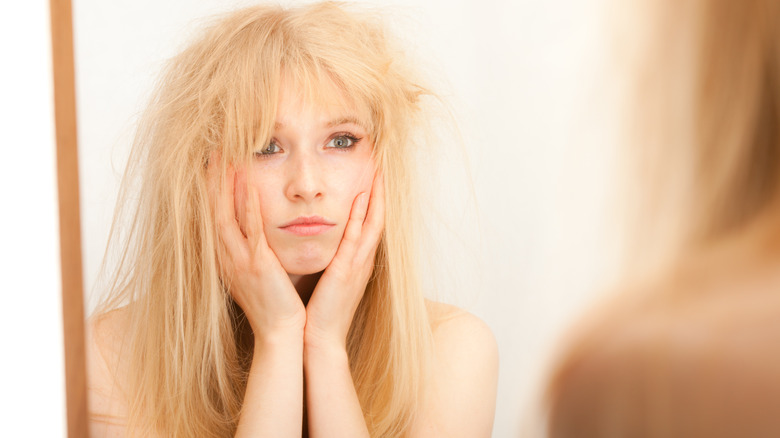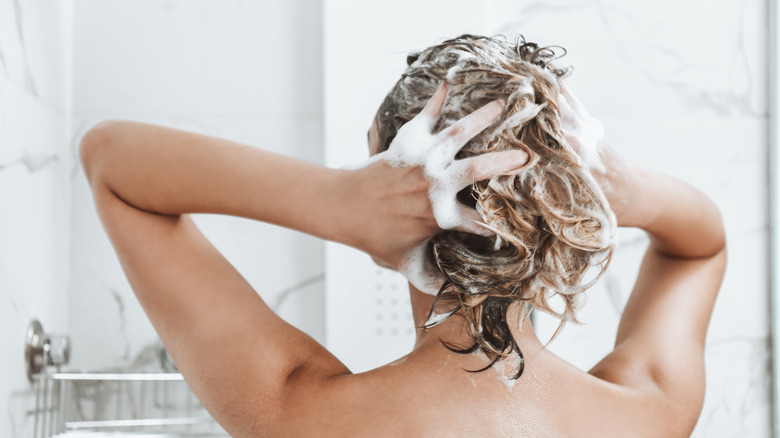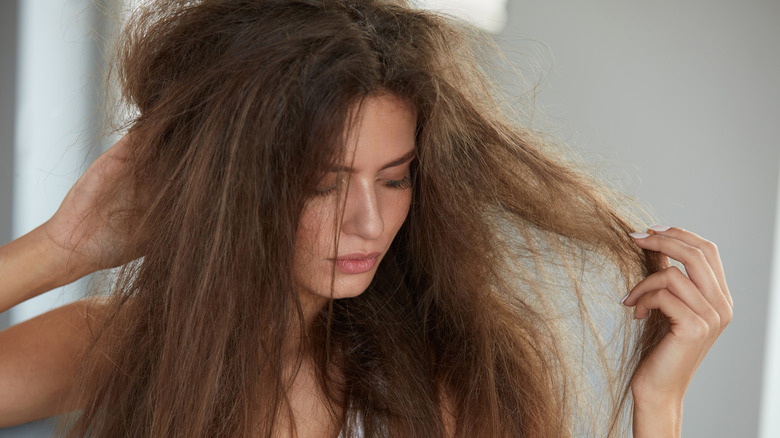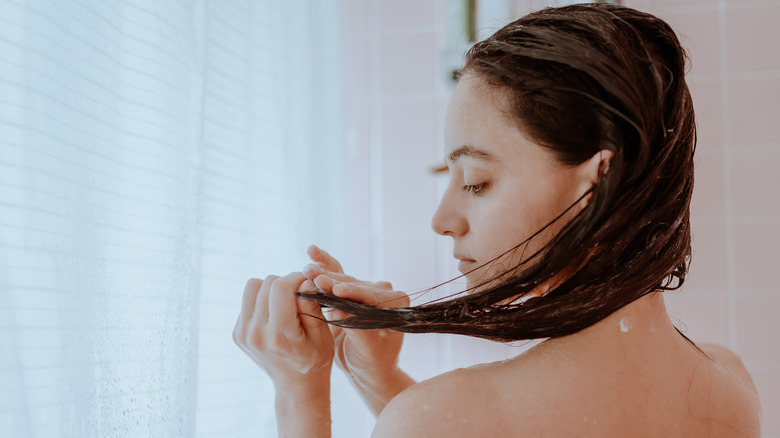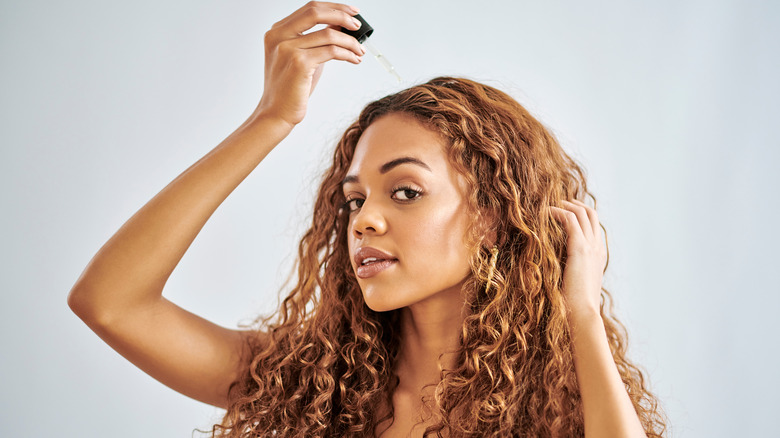Signs Your Hair Is In Protein Overload (& How To Fix It)
With so many beauty and haircare recommendations on the internet these days, it can be easy to get overwhelmed. Our favorite gurus all tout different routines, and the shower ledge only has space for so many different shampoos. Unsurprisingly, your hair can start to feel a bit overloaded as well.
While you might invest in new products with the best of intentions, your hair may have different needs and qualities than that of the influencers on your TikTok feed. As you experiment and look for your favorite combination of care products, it's important to remember to give your hair a break every once in a while. Buildup of extra product can cause unpleasant hair texture, breakage, and even a dreaded phenomenon that you may have heard of: protein overload. Though its name conjures an image of a gym bro with a shake-induced brain freeze, this haircare crisis could actually be the source of damaged, dry locks. Here's what to know and watch out for.
What does protein mean for your hair?
Protein is often associated with muscle-building — but it forms the foundation of many other tissues! Classic sites of beauty and expression (like your skin and fingernails) also benefit from getting enough protein. The strength and health of your hair is no exception, and is highly dependent on a protein called keratin. Up to 85% of your hair structure is actually keratin.
Consuming protein in your diet is typically sufficient to have your body redirect the necessary amino acids toward keeping your hair healthy. Common sources of protein are red meat, eggs, beans, and dairy products. A protein deficiency can manifest in many different ways, as outlined by UCLA Health. You may feel fatigued or frequently suffer stress fractures. You may also notice breakage in your nails and hair. This often prompts people to seek out protein treatments for their hair to restore it to its former glory. While these are great for short-term boosts, an over-reliance on these keratin-backed shampoos and treatments can lead to protein overload.
How does protein overload happen?
In general, your body is good at regulating where protein and its benefits need to be directed. Because of this, your hair won't experience protein overload simply from you eating a very protein-rich diet. Don't let the fear of brittle hair dissuade you from your pre-workout or morning eggs.
However, protein overload is a real problem, and your products may be to blame. Although keratin is an essential component of your hair and the occasional serum or hair mask is a fun part of any self-care routine, introducing too many protein-rich formulas to your repertoire can leave your hair feeling dry.
As Stylecraze explains, hair follicles have a hard time absorbing water when they're already overloaded with keratin. Brittle hair can be a result of low protein, but it can also be a sign that too much protein is blocking water from accessing the strands. So how can you tell the difference between a deficiency and a keratin treatment gone wrong?
What does protein overload look like?
If you suspect that your hair might be in protein overload, there are a few telltale signs to look out for. Pay attention to the look and texture of your hair. If you had been experiencing dry hair, you may have started protein treatments to return your hair to its former condition. Overloaded hair, however, will appear different than your natural texture. Namely, it will feel dry, brittle, fragile, and may even lack its visual shine.
Protein-overloaded hair may also reveal itself during the styling process. As you brush through your locks, you might notice an unexplainable excess of shedding into your brush. Overburdened, weighed-down hair could also struggle to hold a curl. Clearly, keratin buildup doesn't come without its consequences. Fortunately, it's not an irreversible issue, and you may not even have to invest in a new product to get back to your former glory.
How to repair protein overload
As previously mentioned, protein overload doesn't occur without the introduction of too many protein-rich products. As a result, the first step in repairing your hair is giving it a break from your go-to keratin-packed faves. Go back to basics and let your body's natural production of protein take the reins.
Of course, you may have been introducing protein into your hair-care routine without even realizing it. There are a few ingredients to watch out for. Additives like soy or silk protein, hydrolyzed collagen, or amino acids are often advertised as perks of a particular brand. If you're already getting more than enough protein, however, those buzzwords are ones to avoid.
If your hair is feeling really damaged and weighed-down, there are a few things you can do to accelerate your fresh start. Protein can cause breakage and split ends, so a trim can help refresh your look and eliminate any permanently broken strands. Adding a clarifying shampoo to your new routine can also be helpful. These products are specially formulated to tackle buildup. Don't become too reliant on them, though — like protein-packed shampoos, they're meant for occasional use and can otherwise cause damage.
How to safely use protein products
It's understandable that an experience of protein overload (or even its presence as a possibility) could scare you away from treatments or keratin products. However, the benefits that drew you to these products in the first place are still real, and they can be incorporated into your hair routine safely.
Firstly, if you're not already struggling with dry hair, you may not need to seek out protein-rich products. Although they're popular and their advertised benefits are certainly eye-catching, protein can actually do more harm than good for healthy hair. In the case of keratin, there is such a thing as too much of a good thing. It's essential to understand how you should really be using hair masks, treatments, and specialty shampoos. It's all about knowing what your hair needs, not just jumping on the bandwagon.
If you do think you'd benefit from some additional protein, pay attention to package instructions about frequency of use and only try out one keratin-infused product at a time. If the instructions aren't clear, stick with treating your hair every one to two months, or invest in a more user-friendly product. When in doubt, consult with your hairstylist!
